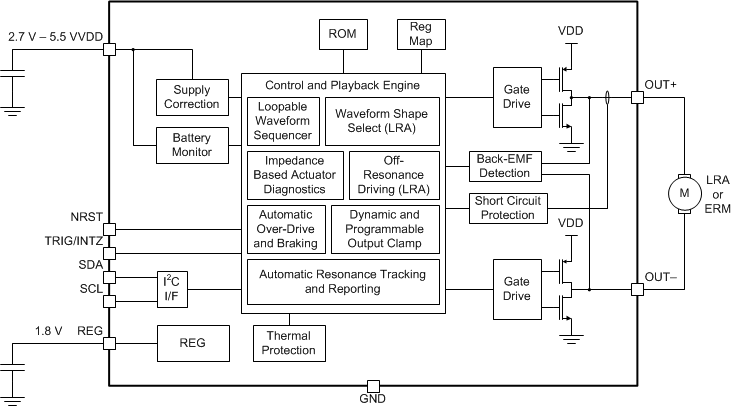ZHCSEH1A December 2015 – December 2015 DRV2625
PRODUCTION DATA.
- 1 特性
- 2 应用范围
- 3 说明
- 4 修订历史记录
- 5 Pin Configuration and Functions
- 6 Specifications
- 7 Parameter Measurement Information
-
8 Detailed Description
- 8.1 Overview
- 8.2 Functional Block Diagram
- 8.3
Feature Description
- 8.3.1 Support for ERM and LRA Actuators
- 8.3.2 Smart-Loop Architecture
- 8.3.3 Open-Loop Operation
- 8.3.4 Flexible Front-End Interface
- 8.3.5 Noise Gate Control
- 8.3.6 Edge Rate Control
- 8.3.7 Constant Vibration Strength
- 8.3.8 Battery Voltage Reporting
- 8.3.9 Ultra Low-Power Shutdown
- 8.3.10 Automatic Go-To-Stand-by (Low Power)
- 8.3.11 I2C Watchdog Timer
- 8.3.12 Device Protection
- 8.3.13 POR
- 8.3.14 Silicon Revision Control
- 8.3.15 Support for LRA and ERM Actuators
- 8.3.16 Multi-Purpose Pin Functionality
- 8.3.17 Automatic Transition to Standby State
- 8.3.18 Automatic Brake into Standby
- 8.3.19 Battery Monitoring and Power Preservation
- 8.4 Device Functional Modes
- 8.5 Operation During Exceptional Conditions
- 8.6
Programming
- 8.6.1 Auto-Resonance Engine Programming for the LRA
- 8.6.2 Automatic-Level Calibration Programming
- 8.6.3 I2C Interface
- 8.6.4 Programming for Open-Loop Operation
- 8.6.5 Programming for Closed-Loop Operation
- 8.6.6 Diagnostics Routine
- 8.6.7 Calibration Routine
- 8.6.8 Waveform Playback Programming
- 8.6.9 Waveform Setup and Playback
- 8.7
Register Map
- 8.7.1 Address: 0x00
- 8.7.2 Address: 0x01
- 8.7.3 Address: 0x02
- 8.7.4 Address: 0x03
- 8.7.5 Address: 0x04
- 8.7.6 Address: 0x05
- 8.7.7 Address: 0x06
- 8.7.8 Address: 0x07
- 8.7.9 Address: 0x08
- 8.7.10 Address: 0x09
- 8.7.11 Address: 0x0A
- 8.7.12 Address: 0x0B
- 8.7.13 Address: 0x0C
- 8.7.14 Address: 0x0D
- 8.7.15 Address: 0x0E
- 8.7.16 Address: 0x0F
- 8.7.17 Address: 0x10
- 8.7.18 Address: 0x11
- 8.7.19 Address: 0x12
- 8.7.20 Address: 0x13
- 8.7.21 Address: 0x14
- 8.7.22 Address: 0x15
- 8.7.23 Address: 0x16
- 8.7.24 Address: 0x17
- 8.7.25 Address: 0x18
- 8.7.26 Address: 0x19
- 8.7.27 Address: 0x1A
- 8.7.28 Address: 0x1B
- 8.7.29 Address: 0x1C
- 8.7.30 Address: 0x1D
- 8.7.31 Address: 0x1F
- 8.7.32 Address: 0x20
- 8.7.33 Address: 0x21
- 8.7.34 Address: 0x22
- 8.7.35 Address: 0x23
- 8.7.36 Address: 0x24
- 8.7.37 Address: 0x25
- 8.7.38 Address: 0x26
- 8.7.39 Address: 0x27
- 8.7.40 Address: 0x28
- 8.7.41 Address: 0x29
- 8.7.42 Address: 0x2A
- 8.7.43 Address: 0x2C
- 8.7.44 Address: 0x2E
- 8.7.45 Address: 0x2F
- 8.7.46 Address: 0x30
- 9 Application and Implementation
- 10Power Supply Recommendations
- 11Layout
- 12器件和文档支持
- 13机械、封装和可订购信息
1 特性
- 超低功耗关断模式
- 低功耗待机状态
- 基于电阻的执行器诊断
- SimpleDrive 单线制振动方案
- 自动谐振跟踪和报告
- 自动过驱动和制动
- 自动级别校准
- 可在电池放电过程进行驱动补偿
- 可配置电池监视器和电源保护
- 具有自动制动的非谐振驱动
- LRA 波形形状选择
- 已获得许可的 Immersion TouchSense®2200
- 内置库和可循环波形序列器
- 实时回放 (RTP) 模式
- I2C 控制的数字回放引擎
- 硬件和软件触发器选项
- 通过自动制动自动切换到待机模式
- 可选中断引脚
- 1.8V 兼容、VDD 耐压数字接口 (1)
(1)正在申请专利的控制算法
2 应用范围
- 手机和平板电脑
- 健身腕带和可穿戴式设备
- 远程控制、鼠标和外设器件
- 支持触觉反馈的器件
- 人机界面
3 说明
DRV2625 器件是一款触觉驱动器,依赖于专有闭环架构提供敏锐、强劲且恒定的触觉效果,同时实现功率最优化。
该器件具有内置库和可循环波形序列器,以及自动过驱和制动功能,可轻松生成清晰优质的触觉效果,从而减轻了处理单元的负担。
DRV2625 器件 特有 自动进入待机状态功能和电池保护功能,无需用户干预即可帮助降低功耗。通过 NRST 引脚可使器件进入完全关断状态,从而节省更多的电能。
通过波形形状选择可以实现正弦波和方波驱动,从而定制触感和可闻性能。具有自动制动的非谐振驱动简化了非谐振触觉解决方案的实现。
器件信息(1)
| 器件名称 | 封装 | 封装尺寸(最大值) |
|---|---|---|
| DRV2625 | DSBGA (9) | 1.498mm × 1.361mm |
(1) 要了解所有可用封装,请见数据表末尾的可订购米6体育平台手机版_好二三四附录。
简化电路原理图
